

Don't Be a Square - Lesson. Summary After watching video clips from the Harry Potter and the Goblet of Fire movie, students explore the use of Punnett squares to predict genetic trait inheritance.
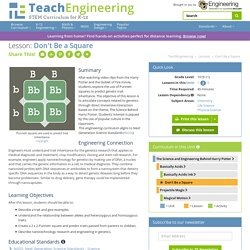
The objective of this lesson is to articulate concepts related to genetics through direct immersive interaction based on the theme, The Science Behind Harry Potter. Students' interest is piqued by the use of popular culture in the classroom. This engineering curriculum aligns to Next Generation Science Standards (NGSS). Engineering Connection Engineers must understand trait inheritance for the genetics research that applies to medical diagnoses and treatment, crop modification, cloning and stem cell research. Chapter 1: Matter—Solids, Liquids, and Gases. Note: Some solids, liquids, and gases are made of atoms, and some are made of molecules.
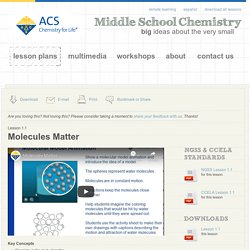
Since the concepts covered in Chapter 1 apply to both atoms and molecules, the term “particle” is used as a generic term to include both. At this point, it is enough to give students simple working definitions of “atom” and “molecule.” (1) The wacky history of cell theory - Lauren Royal-Woods. Chapter 1: Matter—Solids, Liquids, and Gases. Biology Lesson Plans: High School Labs, Activities, Projects. Resources for science teachersThe New Science Teacher. PowerSchool Learning : Health : Class outline. CS Lesson1Teacher. How To Set Up Science Stations In Your Classroom. Science Stations are a great way to increase student engagement and responsibility.
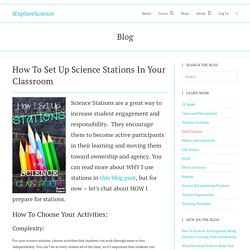
They encourage them to become active participants in their learning and moving them toward ownership and agency. You can read more about WHY I use stations in this blog post, but for now – let’s chat about HOW I prepare for stations. How To Choose Your Activities: Complexity: For your science stations, choose activities that students can work through more or less independently. While students may struggle with this type of independence initially, as you use science stations more frequently, they will become accustomed to doing some “figuring out” on their own. Lastly, each science station should have simple instructions. Examples: Content: I use the 5E instructional model in my classroom, and I have found that science station work is perfect for Explore activities.
I also use it for initial Explain activities, but I always follow up with a whole-group review. Stations of Light - Activity. Summary Student groups rotate through four stations to examine light energy behavior: refraction, magnification, prisms and polarization.

They see how a beam of light is refracted (bent) through various transparent mediums. While learning how a magnifying glass works, students see how the orientation of an image changes with the distance of the lens from its focal point. They also discover how a prism works by refracting light and making rainbows. And, students investigate the polar nature of light using sunglasses and polarized light film. Kesler Science. Science Fair Project Ideas, Answers, & Tools.
Genetics Basics - Biology Worksheets. 3D Mint Tin Cell Model. Biology (cell structures & functions) - Make It Happen Edu. Quality Examples of Science Lessons and Units. In an effort to identify and shine a spotlight on emerging examples of high quality lessons and units designed for the NGSS, Achieve launched the EQuIP Peer Review Panel for Science (PRP).
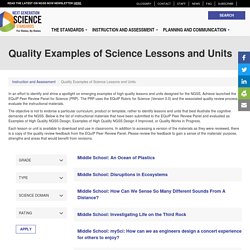
The PRP uses the EQuIP Rubric for Science (Version 3.0) and the associated quality review process to evaluate the instructional materials. The objective is not to endorse a particular curriculum, product or template, rather to identify lessons and units that best illustrate the cognitive demands of the NGSS. Below is the list of instructional materials that have been submitted to the EQuIP Peer Review Panel and evaluated as Examples of High Quality NGSS Design, Examples of High Quality NGSS Design if Improved, or Quality Works in Progress. Each lesson or unit is available to download and use in classrooms. In addition to accessing a version of the materials as they were reviewed, there is a copy of the quality review feedback from the EQuIP Peer Review Panel. Cell Structures and Functions Using SketchUp.
Cell Parts and Functions This lesson introduces students to the structure and functions of organelle ... Page 6: Instructional Methods. Page 6: Instructional Methods The Sycamore Middle School team now has an understanding of how to apply UDL principles to instructional goals and materials.

They also need to evaluate the instructional methods they use to teach content. They discover that, just as they need to present materials in multiple formats, they need to use a variety of instructional methods to deliver the content to all learners. The traditional instructional methods are not especially flexible, nor do they provide students with many options for accessing content. For the most part, they promote passive learning—students are required to memorize information from the text, lecture, or video.
Again, the Sycamore teachers evaluate the sixth-grade lesson on ancient Egypt, this time focusing on the instructional methods used to teach the content. Representation. MS-LS1-2 — The Wonder of Science. Seventh grade Lesson Cellular City - A Closer Look at Cell Structure. 1.
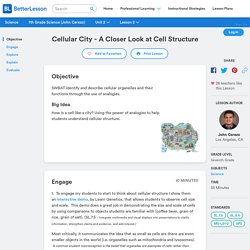
To engage my students to start to think about cellular structure I show them an interactive demo, by Learn Genetics, that allows students to observe cell size and scale. This demo does a great job in demonstrating the size and scale of cells by using comparisons to objects students are familiar with (coffee bean, grain of rice, grain of salt). (SL.7.5 - Integrate multimedia and visual displays into presentations to clarify information, strengthen claims and evidence, and add interest.) Most critically, it communicates the idea that as small as cells are there are even smaller objects in the world (i.e. organelles such as mitochondria and lysosomes). A common student misconception is the belief that organelles are examples of cells rather than components of cells. 2. Lesson 5: Unicellular and Multicellular Organisms - Ms. Plank: Grade 7/8. Characteristics of Protists – Biology 2e. Learning Objectives By the end of this section, you will be able to do the following: Describe the cell structure characteristics of protistsDescribe the metabolic diversity of protistsDescribe the life cycle diversity of protists There are over 100,000 described living species of protists, and it is unclear how many undescribed species may exist.
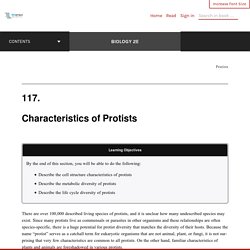
Since many protists live as commensals or parasites in other organisms and these relationships are often species-specific, there is a huge potential for protist diversity that matches the diversity of their hosts. Because the name “protist” serves as a catchall term for eukaryotic organisms that are not animal, plant, or fungi, it is not surprising that very few characteristics are common to all protists. Lesson Plan - Casey's Collection. EdTPA Indirect Instruction Lesson Plan Unicellular and Multicellular Organisms Introduction ________________________________________________________________________ Central Focus/Big Idea: Structures of living organisms in life science.Subject of this lesson: Introduction of unicellular and multicellular organisms.
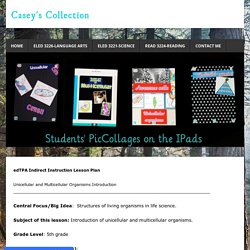
Grade Level: 5th gradeNC Essential Standard(s): 5.L.1.1 Explain why some organisms are capable of surviving as a single cell while others require many cells that are specialized to survive.Next Generation Science Standard(s): MS-LS1-1. Conduct an investigation to provide evidence that living things are made of cells; either one cell or many different numbers and types of cells. MS-LS1-2.